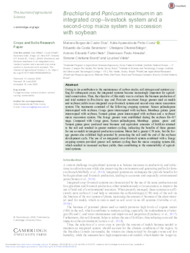Brachiaria and Panicum maximum in an integrated crop-livestock system and a second-crop maize system in succession with soybean.
Brachiaria and Panicum maximum in an integrated crop-livestock system and a second-crop maize system in succession with soybean.
Author(s): DIAS, M. B. de C.; COSTA, K. A. de P.; SEVERIANO, E. da C.; BILEGO, U. O.; FURTINI NETO, A. E.; ALMEIDA, D. P.; BRAND, S. P.; VILELA, L.
Summary: Owing to its contribution to the maintenance of carbon stocks, soil nitrogen and nutrient cycling for subsequent crops, the integrated systems become increasingly important for agricultural conservation. Thus, the objective of this study was to evaluate the biomass production of and total nutrient in Brachiaria spp. and Panicum maximum forage grasses used as mulch and soybean yields in an integrated crop?livestock system and second-crop maize succession system. The treatments consisted of the following cropping systems: Xaraes palisadegrass intercropped with soybean, Congo grass intercropped with soybean, Mombaça guinea grass intercropped with soybean, Tamani guinea grass intercropped with soybean and a soybean/ maize succession system. The forage grasses were established during the soybean R6?R7 stage. Compared with Congo grass, Xaraes palisadegrass, Mombaça guinea grass and Tamani guinea grass produced more biomass and equivalent amounts of fertilizer returned to the soil and resulted in greater nutrient cycling, indicating the benefits of these grasses for use as mulch in integrated production systems. Maize had a greater C/N ratio, but the forage grasses also exhibited high potential by protecting the soil until the end of the soybean development cycle. The use of an integrated crop?livestock system combined with a forage cropping system provided greater soil nutrient cycling than the maize cropping system did, which resulted in increased soybean yields, thus contributing to the sustainability of agricultural systems.
Publication year: 2020
Types of publication: Journal article
Unit: Embrapa Cerrados
Keywords: Biomassa, Nutriente, Planta Forrageira, Sistema de integração, Sustentabilidade
Observation
Some of Embrapa's publications are published as ePub files. To read them, use or download one of the following free software options to your computer or mobile device. Android: Google Play Books; IOS: iBooks; Windows and Linux: Calibre.
Access other publications
Access the Agricultural Research Database (BDPA) to consult Embrapa's full library collection and records.
Visit Embrapa Bookstore to purchase books and other publications sold by Embrapa.

